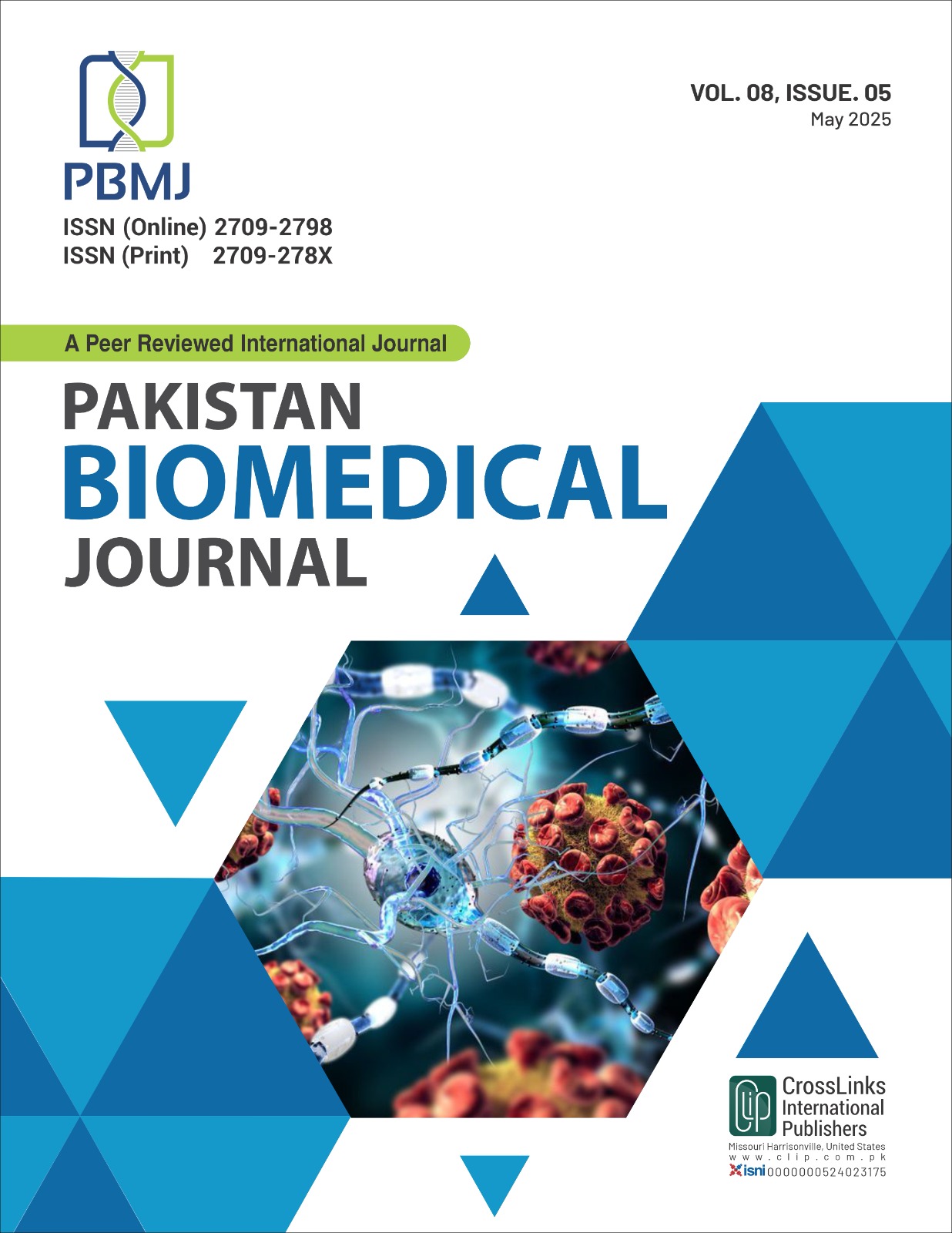Characterization of Placenta Using Ultrasound
Characterization of Placenta
DOI:
https://doi.org/10.54393/pbmj.v8i5.1251Keywords:
Placenta Thickness, Uterus, Ultrasonography, EchotextureAbstract
The placenta is an organ which grows in the uterus when one is pregnant. It aids in the transport of nutrients, oxygen, and eliminates waste products. The placenta is attached to the uterus wall, and the baby's umbilical cord will grow out of it. Usually, it is attached to the top, side, front or back of the uterus. Objectives: To determine placenta, placental thickness, and echotexture and correlate them with gestational age using ultrasonography. Methods: The retrospective study was conducted at the Radiology Department, the private sector, Tehsil Kharian, District Gujrat, Pakistan. The mixed-method sampling approach was applied to collect the data between December 2023 and March 2023. The data were collected on a sample size of 107 patients. The data were taken with the informed consent of the patients in adherence to the ethical norms. SPSS version 20.0 was utilized as the data were entered and analyzed. Results: This study shows 37.4% of female with an anterior, 32.7% of female with a posterior, 7.5% with a left lateral placental location, and 22.4% with a fundal placenta. The study shows a weak positive relationship between placental thickness and gestational age. Conclusions: It was concluded that ultrasonography is reliable for the accurate determination of placental location, thickness, and its correlation with gestational age.
References
Pylypchuk I and Pylypchuk S. Endocrine Function of the Placenta and Its Effect on Pregnancy. Editorial Board. 2021 Jan: 464.
Schleußner E. Endocrinology of the Placenta. In the Placenta: Basics and Clinical Significance. Berlin, Heidelberg: Springer Berlin Heidelberg. 2023 Feb: 91-104. doi: 10.1007/978-3-662-66256-4_5. DOI: https://doi.org/10.1007/978-3-662-66256-4_5
Kojima J, Ono M, Kuji N, Nishi H. Human Chorionic Villous Differentiation and Placental Development. International Journal of Molecular Sciences. 2022 Jul; 23(14): 8003. doi: 10.3390/ijms23148003. DOI: https://doi.org/10.3390/ijms23148003
Schiffer V, van Haren A, De Cubber L, Bons J, Coumans A, van Kuijk SM et al. Ultrasound Evaluation of the Placenta in Healthy and Placental Syndrome Pregnancies: A Systematic Review. European Journal of Obstetrics and Gynaecology and Reproductive Biology. 2021 Jul; 262: 45-56. doi: 10.1016/j.ejogrb.2021.04.042. DOI: https://doi.org/10.1016/j.ejogrb.2021.04.042
Hasegawa K, Ikenoue S, Tanaka Y, Oishi M, Endo T, Sato Y et al. Ultrasonographic Prediction of Placental Invasion in Placenta Previa by Placenta Accreta Index. Journal of Clinical Medicine. 2023 Jan; 12(3): 1090. doi: 10.3390/jcm12031090. DOI: https://doi.org/10.3390/jcm12031090
Bini VS, Gopal AK, Bindhu KM. Second Trimester Placental Location as A Predictor of Adverse Pregnancy Outcomes. National Journal of Physiology, Pharmacy and Pharmacology. 2025 Jan; 14(12): 2636. doi: 10.5455/NJPPP.2024.v14.i12.23. DOI: https://doi.org/10.5455/NJPPP.2024.v14.i12.23
Larcher L, Jauniaux E, Lenzi J, Ragnedda R, Morano D, Valeriani M et al. Ultrasound Diagnosis of Placental and Umbilical Cord Anomalies in Singleton Pregnancies Resulting from in-Vitro Fertilization. Placenta. 2023 Jan; 131: 58-64. doi: 10.1016/j.placenta.2022.11.010. DOI: https://doi.org/10.1016/j.placenta.2022.11.010
Suresh K. Ultrasonographic Measurement of Placental Thickness and Its Correlation with Gestational Age in Normal Pregnancy (Doctoral dissertation, BLDE (Deemed to be University)). 2016.
Lee AJ, Bethune M, Hiscock RJ. Placental Thickness in the Second Trimester: A Pilot Study to Determine the Normal Range. Journal of Ultrasound in Medicine. 2012 Feb; 31(2): 213-8. doi: 10.7863/jum.2012.31.2.213. DOI: https://doi.org/10.7863/jum.2012.31.2.213
Sun X, Shen J, Wang L. Insights into the Role of Placenta Thickness as A Predictive Marker of Perinatal Outcome. Journal of International Medical Research. 2021 Feb; 49(2): 0300060521990969. doi: 10.1177/0300060521990969. DOI: https://doi.org/10.1177/0300060521990969
Afrakhteh M, Moeini A, Taheri MS, Haghighatkhah HR. Correlation Between Placental Thickness in the Second and Third Trimester and Fetal Weight. Revista brasileira de ginecologia e obstetricia. 2013; 35: 317-22. doi: 10.1590/S0100-72032013000700006. DOI: https://doi.org/10.1590/S0100-72032013000700006
Aplin JD, Myers JE, Timms K, Westwood M. Tracking Placental Development in Health and Disease. Nature Reviews Endocrinology. 2020 Sep; 16(9): 479-94. doi: 10.1038/s41574-020-0372-6. DOI: https://doi.org/10.1038/s41574-020-0372-6
Khorami-Sarvestani S, Vanaki N, Shojaeian S, Zarnani K, Stensballe A, Jeddi-Tehrani M et al. Placenta: An Old Organ with New Functions. Frontiers in Immunology. 2024 Apr; 15: 1385762. doi: 10.3389/fimmu.2024.1385762. DOI: https://doi.org/10.3389/fimmu.2024.1385762
Rodriguez-Sibaja MJ, Lopez-Diaz AJ, Valdespino-Vazquez MY, Acevedo-Gallegos S, Amaya-Guel Y, Camarena-Cabrera DM et al. Placental pathology lesions: International Society for Ultrasound in Obstetrics and Gynecology vs Society for Maternal-Fetal Medicine Fetal Growth Restriction Definitions. American Journal of Obstetrics and Gynaecology Maternal-Fetal Medicine. 2024 Aug; 6(8): 101422. doi: 10.1016/j.ajogmf.2024.101422. DOI: https://doi.org/10.1016/j.ajogmf.2024.101422
Azagidi AS, Ibitoye BO, Makinde ON, Idowu BM, Aderibigbe AS. Fetal Gestational Age Determination Using Ultrasound Placental Thickness. Journal of Medical Ultrasound. 2020 Jan; 28(1): 17-23. doi: 10.4103/JMU.JMU_127_18. DOI: https://doi.org/10.4103/JMU.JMU_127_18
Ohagwu CC, Abu PO, Udoh BE. Placental Thickness: A Sonographic Indicator of Gestational Age in Normal Singleton Pregnancies in Nigerian Women. Internet Journal of Medical Update-EJOURNAL. 2009; 4(2). doi: 10.4314/ijmu.v4i2.43837. DOI: https://doi.org/10.4314/ijmu.v4i2.43837
Jacob P, Panneerselvam P, Usman N, Vivekanandan B, Chandrakumar P. Placental Thickness as A Sonological Parameter for Estimating Gestational Age. Journal of Evolution of Medical and Dental Sciences. 2019 Oct; 8: 3074-80. doi: 10.14260/jemds/2019/668. DOI: https://doi.org/10.14260/jemds/2019/668
Karthikeyan T, Subramaniam RK, Johnson WM, Prabhu K. Placental Thickness and Its Correlation to Gestational Age and Foetal Growth Parameters-A Cross-Sectional Ultrasonographic Study. Journal of Clinical and Diagnostic Research. 2012 Dec; 6(10): 1732. doi: 10.7860/JCDR/2012/4867.2652. DOI: https://doi.org/10.7860/JCDR/2012/4867.2652
Kakumanu PK, Kondragunta C, GandraNR YH. Evaluation of Placental Thickness as an Ultrasonographic Parameter for Estimating Gestational Age of the Fetus in 2nd and 3rd Trimesters. International Journal of Contemporary Medicine Surgery and Radiology. 2018; 3(1): 128-32.
Schwartz N, Sammel MD, Leite R, Parry S. First-Trimester Placental Ultrasound and Maternal Serum Markers as Predictors of Small-For-Gestational-Age Infants. American Journal of Obstetrics and Gynecology. 2014 Sep; 211(3): 253-e1. doi: 10.1016/j.ajog.2014.02.033. DOI: https://doi.org/10.1016/j.ajog.2014.02.033
Downloads
Published
How to Cite
Issue
Section
License
Copyright (c) 2025 Pakistan BioMedical Journal

This work is licensed under a Creative Commons Attribution 4.0 International License.
This is an open-access journal and all the published articles / items are distributed under the terms of the Creative Commons Attribution License, which permits unrestricted use, distribution, and reproduction in any medium, provided the original author and source are credited. For comments editor@pakistanbmj.com











